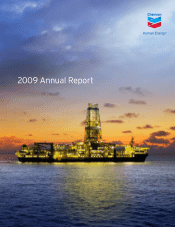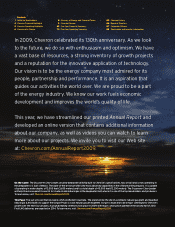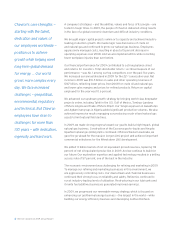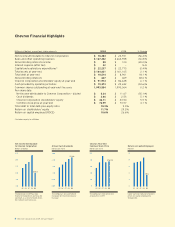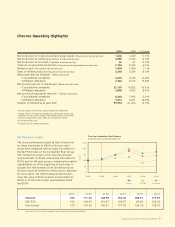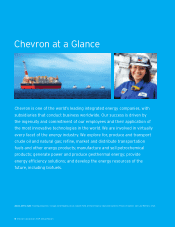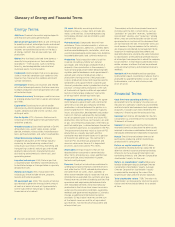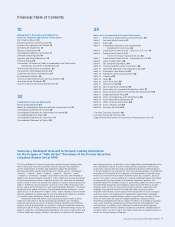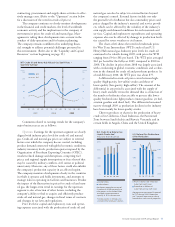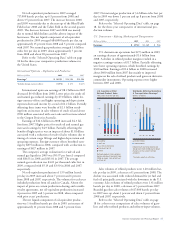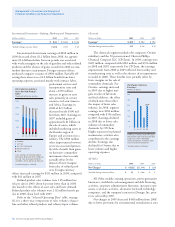Chevron 2009 Annual Report Download - page 10
Download and view the complete annual report
Please find page 10 of the 2009 Chevron annual report below. You can navigate through the pages in the report by either clicking on the pages listed below, or by using the keyword search tool below to find specific information within the annual report.
Glossary of Energy and Financial Terms
Additives Chemicals to control engine deposits
and improve lubricating performance.
Barrels of oil-equivalent (BOE) A unit of measure
to quantify crude oil, natural gas liquids and natural
gas amounts using the same basis. Natural gas
volumes are converted to barrels on the basis
of energy content. See oil-equivalent gas and
production.
Biofuel Any fuel that is derived from biomass —
recently living organisms or their metabolic
byproducts — from sources such as farming,
forestry, and biodegradable industrial and
municipal waste. See renewables.
Condensate Hydrocarbons that are in a gaseous
state at reservoir conditions but condense into
liquid as they travel up the wellbore and reach
surface conditions.
Development Drilling, construction and related
activities following discovery that are necessary
to begin production and transportation of crude
oil and natural gas.
Enhanced recovery Techniques used to increase
or prolong production from crude oil and natural
gas fields.
Exploration Searching for crude oil and/or
natural gas by utilizing geologic and topographical
studies, geophysical and seismic surveys, and
drilling of wells.
Gas-to-liquids (GTL) A process that converts
natural gas into high-quality transportation fuels
and other products.
Greenhouse gases Gases that trap heat in Earth’s
atmosphere (e.g., water vapor, ozone, carbon
dioxide, methane, nitrous oxide, hydrofluorocar-
bons, perfluorocarbons and sulfur hexafluoride).
Integrated energy company A company
engaged in all aspects of the energy industry:
exploring for and producing crude oil and
natural gas (upstream); refining, marketing and
transporting crude oil, natural gas and refined
products (downstream); manufacturing and
distributing petrochemicals (chemicals); and
generating power.
Liquefied natural gas (LNG) Natural gas that
is liquefied under extremely cold temperatures
to facilitate storage or transportation in specially
designed vessels.
Natural gas liquids (NGL) Separated from
natural gas, these include ethane, propane,
butane and natural gasoline.
Oil-equivalent gas (OEG) The volume of natural
gas needed to generate the equivalent amount
of heat as a barrel of crude oil. Approximately
6,000 cubic feet of natural gas is equivalent
to one barrel of crude oil.
Oil sands Naturally occurring mixture of
bitumen (a heavy, viscous form of crude oil),
water, sand and clay. Using hydroprocessing
technology, bitumen can be refined to yield
synthetic oil.
Petrochemicals Compounds derived from
petroleum. These include aromatics, which are
used to make plastics, adhesives, synthetic fibers
and household detergents; and olefins, which are
used to make packaging, plastic pipes, tires, batteries,
household detergents and synthetic motor oils.
Production Total production refers to all the
crude oil (including synthetic oil), natural
gas liquids and natural gas produced from a
property. Gross production is the company’s
share of total production before deducting both
royalties paid to landowners and a government’s
agreed-upon share of production under a
production-sharing contract. Net production
is gross production minus both royalties paid to
landowners and a government’s agreed-upon
share of production under a production-sharing
contract. Oil-equivalent production is the sum
of the barrels of liquids and the oil-equivalent
barrels of natural gas produced. See barrels
of oil-equivalent and oil-equivalent gas.
Production-sharing contract (PSC) An agree-
ment between a government and a contractor
(generally an oil and gas company) whereby
production is shared between the parties in a
prearranged manner. The contractor typically
incurs all exploration, development and produc-
tion costs that are subsequently recoverable
out of an agreed-upon share of any future PSC
production, referred to as cost recovery oil and/
or gas. Any remaining production, referred to as
profit oil and/or gas, is shared between the parties
on an agreed-upon basis as stipulated in the PSC.
The government also may retain a share of PSC
production as a royalty payment, and the
contractor may owe income taxes on its portion
of the profit oil and/or gas. The contractor’s
share of PSC oil and/or gas production and
reserves varies over time as it is dependent
on prices, costs and specific PSC terms.
Renewables Energy resources that are not
depleted when consumed or converted into
other forms of energy (e.g., solar, geothermal,
ocean and tide, wind, hydroelectric power,
biofuels and hydrogen).
Reserves Crude oil or natural gas contained in
underground rock formations called reservoirs
and, effective for 2009, saleable hydrocarbons
extracted from oil sands, shale, coalbeds or
other nonrenewable natural resources that are
intended to be upgraded into synthetic oil or gas.
Proved reserves are the estimated quantities that
geoscience and engineering data demonstrate
with reasonable certainty to be economically
producible in the future from known reservoirs
under existing economic conditions, operating
methods and government regulations. Estimates
change as additional information becomes
available. Oil-equivalent reserves are the sum
of the liquids reserves and the oil-equivalent
gas reserves. See barrels of oil-equivalent and
oil-equivalent gas.
The company only discloses proved reserves in
its filings with the SEC. Certain terms, such as
“probable” or “possible” reserves, “potentially
recoverable” volumes, and “resources,” among
others, may be used to describe certain oil and
gas properties in sections of this document that
are not filed with the SEC. These other terms are
used because they are common to the industry,
are measures considered by management to be
important in making capital investment and
operating decisions, and provide some indication
to stockholders of the potential ultimate recovery
of oil and gas from properties in which the company
has an interest. In that regard, potentially recov-
erable volumes are those that can be produced
using all known primary and enhanced recovery
methods.
Synthetic oil A marketable and transportable
hydrocarbon liquid, resembling crude oil, that is
produced by upgrading highly viscous or solid
hydrocarbons, such as extra-heavy crude
oil or oil sands.
Cash flow from operating activities Cash
generated from the company’s businesses; an
indicator of a company’s ability to pay dividends
and fund capital and common stock repurchase
programs. Excludes cash flows related to the
company’s financing and investing activities.
Earnings Net income attributable to Chevron
Corporation as presented on the Consolidated
Statement of Income.
Goodwill An asset representing the future
economic benefits arising from the other assets
acquired in a business combination that are not
individually identified and separately recognized.
Margin The difference between the cost of
purchasing, producing and/or marketing a
product and its sales price.
Return on capital employed (ROCE) Ratio
calculated by dividing earnings (adjusted for
after-tax interest expense and noncontrolling
interests) by the average of total debt, non-
controlling interests and Chevron Corporation
stockholders’ equity for the year.
Return on stockholders’ equity Ratio calcu-
lated by dividing earnings by average Chevron
Corporation stockholders’ equity. Average
Chevron Corporation stockholders’ equity
is computed by averaging the sum of the
beginning-of-year and end-of-year balances.
Total stockholder return (TSR) The return to
stockholders as measured by stock price appre-
ciation and reinvested dividends for a period
of time.
Financial Terms
Energy Terms
8Chevron Corporation 2009 Annual Report
Narrative.cg_R6.indd 8 3/28/10 8:57 AM

